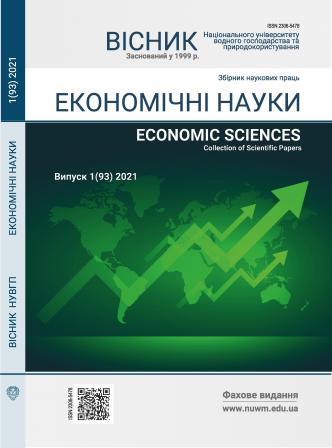ESSENCE OF LAND TRANSFORMATIONS IN AGRICULTURAL CHANGES
DOI:
https://doi.org/10.31713/ve120214Keywords:
land relations, agrarian changes, economic activity, land users, agriculture.Abstract
The article considers the essence of land transformations in agrarian changes. The history of the development of land relations is studied and the conditions that determine their formation and functioning are analyzed. It is determined that the use of land for economic activities is carried out on the basis of land law, the constituent elements of which are the right of ownership, the right to use and the right to dispose of land by the subjects of this right. The system of land management that existed during the Soviet era provided for bans on land agreements and thus helped to preserve the country's land fund and its structure in a more traditional form. With the transition to a market economy, the state monopoly on land was abolished, and this contributed to an increase in the number of grounds for the emergence of private property rights, mainly through contracts of sale, inheritance, gift, will, etc., which could not be in the nationalization conditions.The legislation of Ukraine allows agricultural organizations to use management and move to a corporate form of internal relations. But in practice, the socialized forms of production, labor, and property in the former state and collective farms proved to be very tenacious. The paper emphasizes that the main provisions of agricultural policy and land law should provide for a combination of land use, natural and environmental conditions, their rational operation, which will not harm the components of the biosphere, biogeocenoses and existing ecosystems. This approach will be crucial for the formation of normal social conditions, living conditions, location and operation of infrastructure, recreational areas and other social needs.An organized system of land relations, through the impact on owners and land users, is designed to promote the formation in the production process of a positive energy balance. Land relations should be organized so that producers are interested in the use of intensive farming methods aimed at increasing the photosynthetic activity of plants (highly efficient varieties, adaptive farming systems, etc.) while reducing the energy intensity of production.In conclusion, it is noted that the essence of land transformations inagrarian changes determines the transition to organic and adaptive farmingsystems, renewable energy sources, biofuels, etc., and aims to make changes in land law and, consequently, in land relations.References
Земельний кодекс України № 2768-ІІІ від 25 жовтня 2001 року. URL: http://zakon.rada.gov.ua/ (дата звернення: 16.11.2020).
Мартин А. Г. Регулювання ринку земель в Україні : наукова монографія. К. : Аграр Медіа Груп, 2011. 252 с.
Білик Ю. Д. Формування ринку землі в Україні. К. : Урожай, 2006. 280 с.
Крисак А. І. Земельні ресурси – консолідуючий фундамент господарської самодостатності. Інноваційна економіка. 2013. № 2 (40). С. 129–135.
Добряк Д. С. Напрями вдосконалення нормативно-правової бази регулювання земельних відносин. Землеустрій і кадастр. № 4. 2009. С. 5–10.
Милосердов В. В. Аграрная политика России – XX век. М., 2002. 544 с.
Шутьков А. Проблеми виводу агропромислового комплексу з кризи. АПК: економіка, управління. 2000. № 1. С. 4–17.

